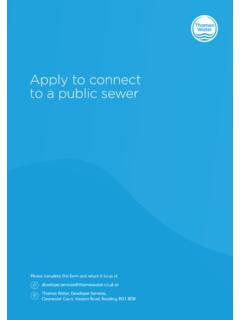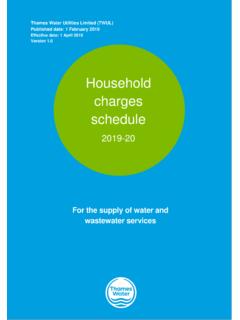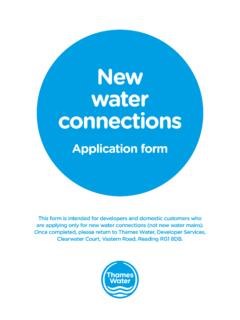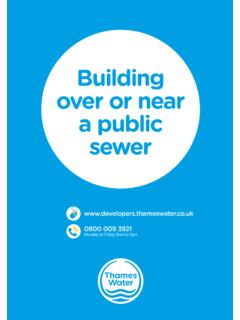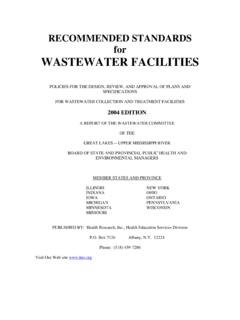Transcription of Your new sewer construction guide - Thames Water
1 Your new sewer construction guide2 Contents2 Why use this guide ?3 Trenches and excavations4 New manholes and chambers6 Pipes and bedding6 Connecting sewers7 Testing of new sewers7 Get in touchWhy use this guide ? We know that the construction of new sewers and lateral drains can add significant time to your already hectic build programme. But poorly built networks can lead to expensive and disruptive repairs, negatively impacting your new homeowners. That s why your groundworker and contractor must use qualified, accredited and competent workers to meet the required standards s what to doPlease read this guide alongside the Design and construction Guidance within the regulator s Code for Adoption. It contains best practices for operatives and contractors to follow on site when laying new sewers that you d like us to adopt.
2 Inside, you can find photographic examples of good practice and poor practice . you re digging to install manholes or to prepare trenches for sewer laying, you must follow HSE guidelines to prevent collapses, slippage, and trips or falls. This means supporting trench walls with boxes or support struts and storing excavated spoil and other materials safely away from open excavations. For more information on working in confined spaces, please visit and excavationsIf dewatering is required to enable construction and you need to discharge groundwater into our sewers, you must obtain our permission more information about groundwater discharge, visit be careful when laying sewers in wet ground. Standing Water , debris, silt, sludge or running sand could easily enter our sewer system, potentially blocking pipes, polluting the local area or impacting our sewage treatment works.
3 Accepted and agreed drawingsPlease make sure your site groundworker has a copy of the drawings that we formally approved. For construction , follow Ofwat s Code for Adoption Design and construction Guidance as well as our additional requirements and local you need to amend the agreed drawings, please submit redesigned proposals so that we can approve the changes. construction and pipe materialsAll the sewerage network materials you use must comply with Ofwat s Code for Adoption as well as the appropriate BS EN certification or WIS store these safely in accordance with the manufacturer s recommendations. This is especially important for sewer pipes, which can easily be damaged when stored you d like to use an alternative product, please talk to us before you buy it, and we ll check its suitability.
4 If we don t think a product is fit for purpose or will last the required lifespan, we reserve the right to refuse its use. 4If there s a vertical or horizontal change in sewer alignment, you ll need to install a manhole or inspection ll need to construct a manhole when:a) the depth from cover level to soffit is greater than 2m or the diameter of the largest sewer is greater than or equal to 450 mm DN/IDb) the chamber contains equipment (eg penstock or flow control device) that requires maintenancec) the chamber serves more than ten propertiesIf maintenance and surveys can be undertaken at ground level, you can construct an inspection/access chamber follow Ofwat s Code for Adoption Design and construction Guidance to align step rungs and position covers correctly for safe access.
5 New manholes and chambersPlease use pre-formed inverts, channel pipes and slippers for all manholes. All connection laterals must enter with the flow to make sure the connecting flow is swept into the main channel. You can use pre-formed manhole bases, but please contact us first to discuss the type and use. You can t use plastic manhole bases in concrete or brick don t allow existing or other utilities to pass through the new chamber instead, you can divert them around chambers and access chambersTo prevent groundwater seeping in, bed concrete manhole rings together using mortar or mastic/bitumen sealing rings. Point, seal and finish the lifting eyes so that they re flush to the internal chamber lifting manhole segments can be dangerous, please follow the HSE guidance on Lifting Operations and Lifting Equipment Regulations (LOLER).
6 5If the overall distance from finished ground level to the benching landing is greater than 3m, please use ladders. Plastic access chambers designed for non-man entry systems are acceptable in non-traffic loading areas or gardens. Typically, these are for shallow systems (max. depth 3m) and are beneficial in areas with limited space. CCTV and jetting equipment must be able to enter the main line for maintenance purposes. Where you use plastic chambers, they must be installed with ironwork cover and you re altering or adjusting manholes to a new or final level, you ll still need to make sure access rungs and ladders follow the set maximum limits and that you raise or lower the manhole cover and frames using the proper materials usually a 1-3 course of solid Class B engineering brickwork, laid in English , you can use pre-cast concrete manhole raising pieces or shimming products if they meet the traffic loading requirements.
7 You can t use any other types of concrete or brickwork materials. Please source manhole covers and frames in accordance with the specifications in the Design and construction Guidance. This usually means 150mm deep covers and frames for trafficked areas, and 100mm deep for gardens or landscaped manhole covers and frames must be rated for the relevant traffic loadings and have a minimum opening size of 600mm by 600mm. Infill paviour covers are typically only suitable for non-trafficked areas and for shared surfaces that experience traffic of 20mph and less. You won t be able to use covers made from aluminum or low grade steel, as these can bend or warp and damage the surrounding paved you wish to use them, they must be manufactured from either grade 316L stainless steel or a minimum 140 micron galvanised steel due to the corrosive nature of common use of de-icing salt.
8 Loading should be fully compliant with BS EN124 loading requirements. Load class A15 where traffic is pedestrian only, and load class B125 for potential 44 ton truck slow moving in any shared surfaces. All infill covers must have lift assist mechanisms, have standard key lifting eyes and be lockable to prevent accidental manholes and chambers sure all step rungs are vertically aligned, equally spaced and designed for easy entry and exit, and align rungs with the access cover and cover slab opening as per our guidelines. For safe access, the distance from finished ground level to the first step should be no more than 675mm, and the first step should be at least 150mm from the underside of the cover and beddingOfwat s Code for Adoption sets clear specifications for all types of pipe materials.
9 This includes traditional clayware, concrete, ductile iron and plastic make sure your chosen product meets the requirements of the appropriate British Standard as well as the minimum loading pipes are expensive and should be stored as per the manufacturer s recommendations, typically on flat surfaces and in specific storage units away from excavations. Please take care to store and handle plastic pipelines carefully to avoid pipes along the entire pipe length based on pipe depth and ground conditions. If you re in doubt about which bedding material to use, please let us know. Connecting sewersWhen the main sewer channel is larger than a proposed lateral connection into a manhole chamber, please make sure the soffit levels are the same. To make maintenance easier for incoming laterals, use half-pipe channels that don t intrude into the main manhole benching in high-strength concrete, laid at a fall of 1 in 10 to prevent debris stubs and rocker pipes immediately outside of manhole chambers on all pipework below 1050mm in you re connecting to the existing public sewer , the number of properties served by the new connection will determine the most appropriate connection can construct new manholes, pre-formed oblique junction connections or flexible plastic saddles, but not T junctions or clay saddles.
10 The internal saddle diameter must not be greater than one third of the main sewer saddles and connections through existing manholes, please core-drill the new incoming pipe connection accurately using circular cutting tools. Don t use a disc cutter or angle saddles and oblique junction connections, make the connection at 9 to 3 o clock but never below the expected diurnal flow height of the main junction connections squarely and accurately by cutting the existing sewer with the appropriate machinery, and join the junction to the existing sewer using proprietary coupling/band sure you test all sewers up to 750mm for compliance. They must also successfully pass an air or Water you ve finished backfilling, you ll need to carry out a CCTV survey on all adoptable sewers. We recommend you jet clean them first to avoid the need for additional in touchPlease contact us as early as possible to discuss any bespoke designs or for any design requirements that are outside the scope of the Design and construction Guidance, which is published by ll help you decide on the best design and enquiries regarding this application or any other questions relating to your building or development work, please contact 009 3921 Monday-Friday, 8am-5pmThames WaterDeveloper ServicesClearwater CourtVastern RoadReadingBerkshire RG1 8 DBTesting of sewersIf an existing public sewer manhole can t safely accommodate your new connection, please consider fitting a new manhole or an alternative option.


